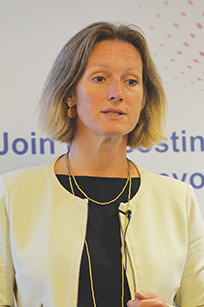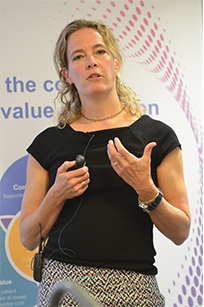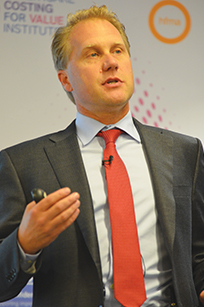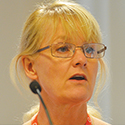Value-based healthcare: making the leap
Value-based healthcare – or VBHC – makes sense. But despite winning a theoretical argument in the UK, there are few examples of organisations or systems that have embedded a formal approach targeting the delivery of value across all services.
 That was the issue October’s international symposium set out to explore, pulling together some of the pioneers of VBHC from across the world to discuss their critical success factors.
That was the issue October’s international symposium set out to explore, pulling together some of the pioneers of VBHC from across the world to discuss their critical success factors.
The first point tackled by the speakers was ensuring the value being delivered is value as defined through the patient’s eyes – what is it that the patient wants/needs, not what is it that the service can provide? That means having patients involved in the design and improvement process from the outset.
Paediatric consultant Helen Leonard said that if true co-production was the goal, then healthcare professionals would need to ‘give up some power’. It would also call for work and investment.
‘Often decisions are made and then someone is invited along afterwards to ask what they think and it’s: “Tick, we’ve done patient engagement”,’ she said. ‘You need to invest in people from the beginning of the design process, and to do that you have to share some of the power and skill people up. You can’t bring people into a strategic or planning meeting if they don’t understand the language.’ Start with patients
Start with patients
‘Our mission is to include patients in everything we do,’ said Samyra Keus, VBHC lead for the Santeon group of hospitals in the Netherlands. Santeon is a network of seven acute hospitals that collectively provide more than 10% of all Dutch hospital care. It formally introduced a VBHC approach in 2016 across five patient groups: breast cancer; prostate cancer; lung cancer; cerebrovascular accident; and hip arthrosis.
As part of this, multidisciplinary teams for each patient group are established at each hospital, with one hospital taking the lead in developing a scorecard identifying 15-20 key outcomes, cost and process metrics.
Patients feature heavily in the process. For outcome measures, Santeon uses the International Consortium for Health Outcomes Measurement indicator sets, which have been put together with patient input.
However, these can be supplemented with other measures and Santeon’s own patient representatives are at the table from the beginning, including overseeing the metric selection and creation of the scorecards.
The outcome measures include both patient-reported outcomes and experiences (PROMs and PREMs). The multidisciplinary team also tracks patient journeys to ensure it maintains a patient’s view of services.
As well as ensuring the hospitals focus on the things that matter to patients, patient involvement has led to real service change.
For example, one patient representative challenged the various lifestyle restrictions suggested post-hip surgery to avoid dislocation. They suggested these were confusing and difficult to comply with.
Research by the trust found little evidence for many of these restrictions and this led to their removal or alteration as part of changes in key literature. Subsequent monitoring has shown that the number of dislocations has in fact gone down.
Even cost indicators are patient driven. ‘If a patient has fewer scans for the same outcome, that is better for the patient and better in terms of costs,’ said Ms Keus. ‘We talk about length of stay, not euros, and about the percentages of patients getting X-rays or MRIs. So even the indicators on cost are important to patients.’
The group is also working on a government sponsored project to create a decision-making tool for patients in three areas – breast cancer, stroke and chronic kidney failure.
 ‘We are looking at outcome indicators and transparency for shared decision-making,’ said Hille Witjes, a breast cancer surgeon from OLVG hospital in Amsterdam. ‘The idea is that the patient should be able to see the outcomes they can expect if they choose a specific treatment option.’
‘We are looking at outcome indicators and transparency for shared decision-making,’ said Hille Witjes, a breast cancer surgeon from OLVG hospital in Amsterdam. ‘The idea is that the patient should be able to see the outcomes they can expect if they choose a specific treatment option.’
Population focus
Improving population health has been the focus for value work in Manchester as part of the devolution programme.
Steve Wilson, executive lead for finance and investment of Greater Manchester Health and Social Care Partnership, emphasised that devolution was about much more than health, although health was an important part of the bigger picture.
Other sectors such as transport and education have an impact on health, and the need for healthcare and health services can support growth in the city.
 ‘There are pockets of really strong economic development and growth, but still enormous pockets of deprivation and as the growth has expanded, that gap has grown,’ he said. ‘The fundamental issue behind devolution was to deliver sustainable growth and to close that gap.’
‘There are pockets of really strong economic development and growth, but still enormous pockets of deprivation and as the growth has expanded, that gap has grown,’ he said. ‘The fundamental issue behind devolution was to deliver sustainable growth and to close that gap.’
There was a clear recognition that poor health in some of the population was actually limiting what the city could hope to achieve with its growth.
To ensure prevention is at the heart of everything, a system architecture has been established that operates at three levels:
- Neighbourhoods, covering 30,000-50,000 population
- Ten localities that bring together community and mental health services, primary care and social care services
- Greater Manchester as a whole, where things need to be done once for the whole population.
‘This [architecture] has allowed us to try to create a population health system that looks at population health as the number one way of influencing health and wellbeing rather than interventions in acute or community settings,’ said Mr Wilson.
The partnership is targeting three areas to make a difference:
• Focusing on the big killers Half of all premature deaths are still linked to preventable factors such as unhealthy diet, inactivity, smoking and alcohol and premature mortality is twice as high in more deprived communities.
• Health creation in every policy All public services in Greater Manchester have health benefits as a recognised objective.
• A unified model of service delivery Based on integrated neighbourhood services.
Mr Wilson said that people needed to think differently about the return on investment in population health, with sometimes higher returns that could take longer to deliver. Currently just 5% of healthcare funding is spent on preventative care. Changing this would mean joining up commissioning budgets so that their scope covered the wider determinants of health.
‘We have invested £0.5m of transformation funds to support work to modify a series of road junctions to improve cycle access,’ he said. As well as obvious public health benefits, this could have a short payback period in terms of eliminating treatment for avoided accidents.
‘This has been matched by investment of up to £0.5bn through the Highways Agency and Transport for Greater Manchester,’ said Mr Wilson. ‘The money we put in is tiny but the opportunities to work with other partnerships is enormous.’Culture change
Several speakers talked about how systems needed the right culture in place to deliver VBHC. In Santeon, while the group board decided value would be the guiding principle, this wasn’t simply imposed on the hospitals. ‘They didn’t give us the goals, but they did give us the freedom,’ said Ms Keus.
This local ownership was key to the programme’s success, as was a focus on quality rather than costs. The centre then supported the individual hospitals by providing project leads and data analysts to support the development of a learning environment.
A similar message came from Michigan, home to the largest value-based reimbursement system in the US outside of the Medicare programme. Insurer Blue Cross Blue Shield Michigan (BCBSM) runs value partnership programmes for both ambulatory and hospital-based care.
‘You have to start with quality, then you can look at cost and, as you build trust in the data and build partnerships, you can address patient experience,’ said Thomas Leyden, value partnerships director at BCBSM.
Ultimately, you can move on to look at appropriateness – the best quality care at the lowest cost is not value if the procedure was not needed in the first place.
‘Our job is to convene and catalyse,’ said Mr Leyden, ‘and to provide dollar rewards for the transformation of care, because it takes funds to transform performance.’
He echoed the Dutch presentation in warning against imposing programmes on medical staff. ‘It has to be about empowerment,’ he said.
A value-based culture also needed to encourage transparency and sharing. Having 40 hospitals delivering bariatric care, or 33 hospitals involved with breast surgery, provided a powerful database to identify and explore variation.
 Scott Flanders, chief clinical strategy officer for the University of Michigan Health System, told the symposium that transparency and being open, in particular about problems, was a key characteristic of the required different culture. Dr Flanders leads one of Michigan’s multi-hospital value programmes looking at hospitalised general medical patients. Current initiatives include hospital-associated venous thromboembolism, intravascular devices and inpatient antimicrobial use.
Scott Flanders, chief clinical strategy officer for the University of Michigan Health System, told the symposium that transparency and being open, in particular about problems, was a key characteristic of the required different culture. Dr Flanders leads one of Michigan’s multi-hospital value programmes looking at hospitalised general medical patients. Current initiatives include hospital-associated venous thromboembolism, intravascular devices and inpatient antimicrobial use.
Each hospital – between 40 and 50 organisations can be involved at different times – brings a team to a collaborative workshop on a quarterly basis. Together, the teams create robust data registries and use the data to decide best practice. ‘Then we do “facilitated implementation”,’ said Dr Flanders. ‘This is not just sharing practice but sometimes creating toolkits or doing site visits and patient walkthroughs to help target some of the problems.’
Hospitals are scored on agreed performance measures, with scores affecting payment, although Dr Flanders said organisations and clinicians were just as motivated by wanting to improve their position.
‘Transparency is critical not just in areas where we are doing well but where we struggle,’ he said. Hospital performance data is not anonymised and struggling hospitals are encouraged to share their challenges.
Making the case
Many trusts want to see a business case for value-based healthcare. However, speakers said organisations simply had to get stuck in. They emphasised that quality improvement was the way in and that efficient use of resources would follow. Ms Keus advised organisations to ‘start small, be pragmatic and base work on trust’ and successes would lead to a snowball effect.
Dr Flanders believed that putting a figure to savings could be difficult. However, Michigan’s work on venous thromboembolism had led to significant improvements. The Michigan hospitals had in general experienced increased use of pharmacologic prophylaxis (blood thinners) to guard against blood clots for hospitalised patients, in line with national guidance. However, its own study found no better outcomes in hospitals with the higher rates of prophylaxis.
Further work identified a smaller subset of patients who would benefit from this approach, with different strategies employed for other patients.
Implementation of this across its hospitals led to 850 fewer blood clots over a year, with 1,200 fewer clinically significant bleeding episodes. With a deep vein thrombosis costing up to $11,000 on average and a pulmonary embolism costing up to $17,000, the possible savings that could be linked to these changes are significant.
And with the work having been disseminated across the country, influencing the published guidelines, it has had a far wider impact too.
One message was clear. Value-based healthcare has to be a way of operating. It is not a one-off improvement programme, but has to become the way that services develop going forward. Improvements have to be sustained, which involves monitoring, and dips in performance have to be corrected. And, as issues get fixed, other issues can be prioritised. In this sense, it does not have an end goal.
None of the health systems featured in the symposium claim to be the finished article in terms of delivering embedded value-based healthcare across all services.
They would all recognise improvements that could be made in terms of patient involvement, looking more broadly at population health rather than just healthcare.
They would also identify issues that could be improved in their own culture and recognise the continued need to demonstrate that value is being delivered. But they are very definitely on the road to delivering better, more sustainable care. And they would all encourage others to join them on the journey.
• Healthcare Costing for Value Institute members can access presentations and videos from the symposium at hfma.to/ah
Value in action
 Paediatric consultant Helen Leonard said that the NHS was good at identifying good outcomes for single-issue ‘fixable’ conditions, such as a heart attack or trauma, but it fell short for complex patients where there were multi-factoral needs.
Paediatric consultant Helen Leonard said that the NHS was good at identifying good outcomes for single-issue ‘fixable’ conditions, such as a heart attack or trauma, but it fell short for complex patients where there were multi-factoral needs.
Drawing on her own disappointing initial experiences of health and social care with her son Matthew, who was born with severe learning disabilities, physical disabilities and cerebral visual impairment, she said patients and their families had to be seen as the ‘most useful assets’ in determining what would constitute success or value in individual cases.
Personal health budgets offered a way of delivering real value – effective support for patients at lower cost – and should be offered more widely.
 Petri Kivinen is chief medical officer of Siun Sote, the joint municipal authority for North Karelia’s social and health services in Finland. He told the conference that delivering value demands working across silos. This means health and social care professionals working together to develop better pathways and using a common budget.
Petri Kivinen is chief medical officer of Siun Sote, the joint municipal authority for North Karelia’s social and health services in Finland. He told the conference that delivering value demands working across silos. This means health and social care professionals working together to develop better pathways and using a common budget.
But he said it was also important to co-operate with bodies outside of healthcare, such as schools and emergency services. As a minimum, this meant sharing data.
 Gunther Jonitz, president of the Berlin Chamber of Physicians, described a prostate cancer network that has been developed to really harness patient power. Progether is an ambitious project that aims to establish a database of prostate cancer knowledge.
Gunther Jonitz, president of the Berlin Chamber of Physicians, described a prostate cancer network that has been developed to really harness patient power. Progether is an ambitious project that aims to establish a database of prostate cancer knowledge.
While it is currently operational in Germany, the intention is to extend the project globally. Patients can monitor their cancer online and collect and enter cancer data, tests, treatments and patient reported outcome measures (PROMs) in an organised way – helping them to learn more about their disease and informing the development of treatments.
Paul Buss, consultant paediatrician and medical director of Aneurin Bevan University Health Board, has led a five-year value-based healthcare programme at the Welsh board – arguably the UK’s most advanced VBHC organisation.
The approach involves forensic analysis and discussion of variation across its services and, where applicable, establishing a best practice model. It collects wide-ranging outcome measures and other data. For example, a renal care programme has been exploring outcomes for different dialysis interventions alongside frailty scores to inform shared decision-making.
‘The aim is to be able to say that, if you have this treatment in this place, it will be likely to have this effect on you if you started with this frailty and comorbidity,’ said Dr Buss.
Related content
We are excited to bring you a fun packed Eastern Branch Conference in 2025 over three days.
This event is for those that will benefit from an overview of costing in the NHS or those new to costing and will cover why we cost and the processes.